家用空调器欧洲能效的要求和测试_方法
- 格式:pdf
- 大小:664.30 KB
- 文档页数:8
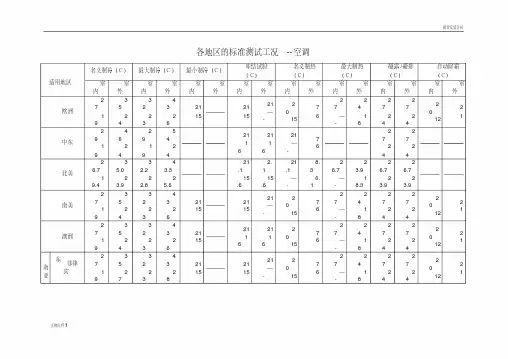
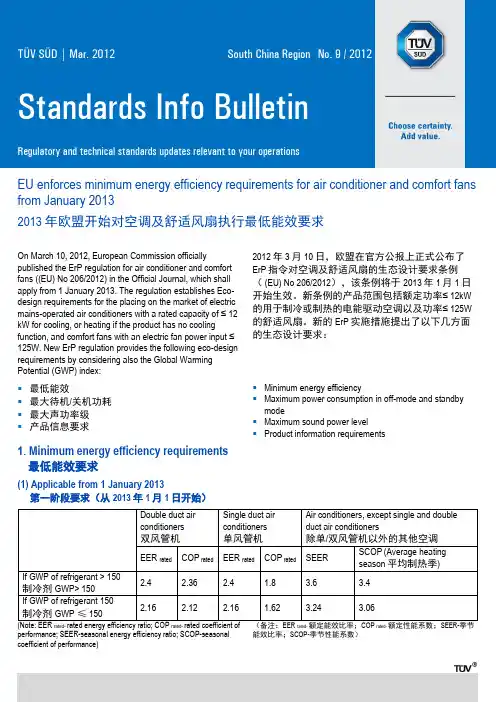
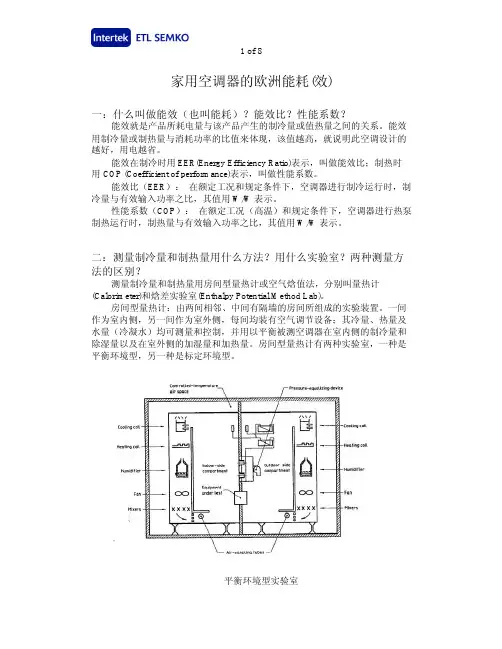

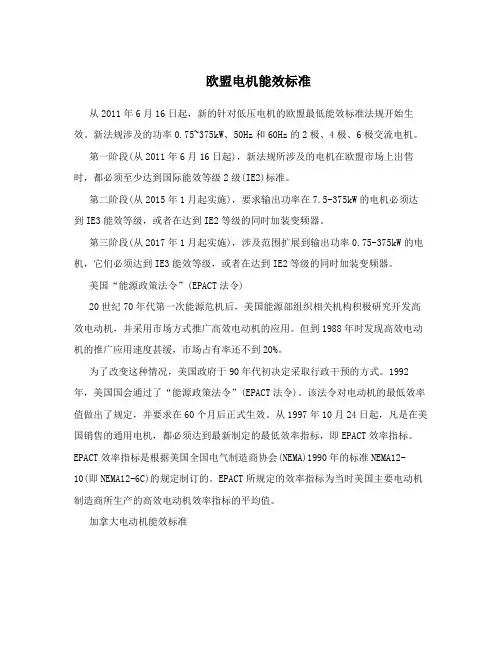
欧盟电机能效标准从2011年6月16日起,新的针对低压电机的欧盟最低能效标准法规开始生效。
新法规涉及的功率0.75~375kW、50Hz和60Hz的2极、4极、6极交流电机。
第一阶段(从2011年6月16日起),新法规所涉及的电机在欧盟市场上出售时,都必须至少达到国际能效等级2级(IE2)标准。
第二阶段(从2015年1月起实施),要求输出功率在7.5-375kW的电机必须达到IE3能效等级,或者在达到IE2等级的同时加装变频器。
第三阶段(从2017年1月起实施),涉及范围扩展到输出功率0.75-375kW的电机,它们必须达到IE3能效等级,或者在达到IE2等级的同时加装变频器。
美国“能源政策法令”(EPACT法令)20世纪70年代第一次能源危机后,美国能源部组织相关机构积极研究开发高效电动机,并采用市场方式推广高效电动机的应用。
但到1988年时发现高效电动机的推广应用速度甚缓,市场占有率还不到20%。
为了改变这种情况,美国政府于90年代初决定采取行政干预的方式。
1992年,美国国会通过了“能源政策法令”(EPACT法令)。
该法令对电动机的最低效率值做出了规定,并要求在60个月后正式生效。
从1997年10月24日起,凡是在美国销售的通用电机,都必须达到最新制定的最低效率指标,即EPACT效率指标。
EPACT效率指标是根据美国全国电气制造商协会(NEMA)1990年的标准NEMA12-10(即NEMA12-6C)的规定制订的。
EPACT所规定的效率指标为当时美国主要电动机制造商所生产的高效电动机效率指标的平均值。
加拿大电动机能效标准1992年加拿大议会通过了能源效率法令(EEACT),其中包括了电动机的最低能效标准,并规定该标准在1997年开始正式生效,其电动机效率指标和美国EPACT 指标相同。
由于此标标准依据法令固定强制实施,所以高校率电动机在加拿大得到了迅速的推广。
澳大利亚、新西兰电动机能效标准澳大利亚政府为节约能源和保护环境,自1999年起开始对家用电器和工业设备实施强制性能效标准计划(Mandatory Energy Efficiency Per-formance Standards),或称MEPS计划,由澳大利亚政府下属温室气体办公室会同澳大利亚标准委员会进行管理。
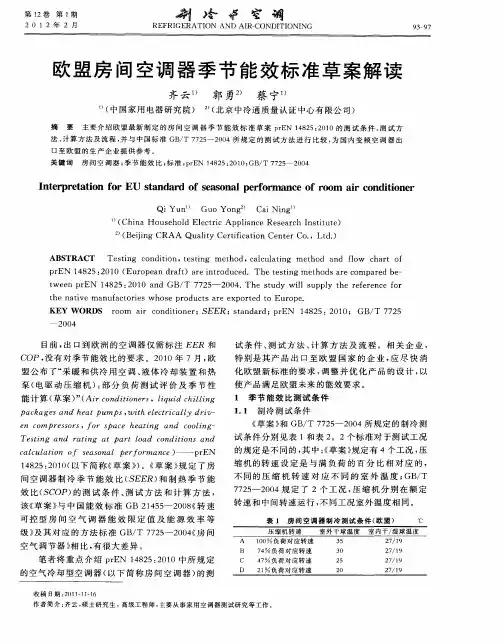
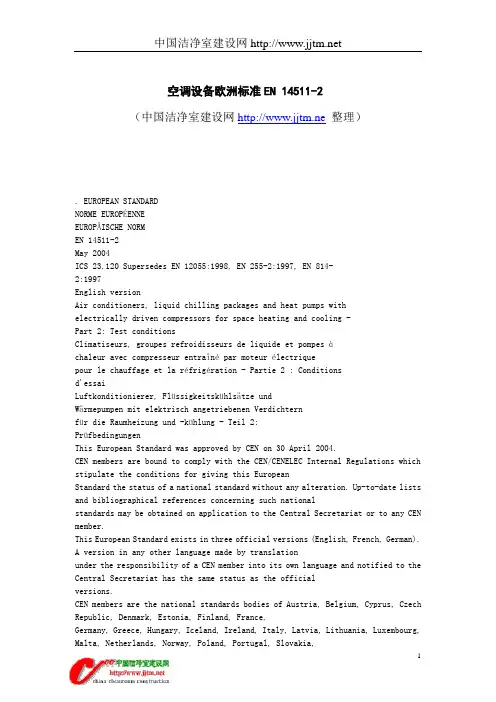
空调设备欧洲标准EN 14511-2(中国洁净室建设网http://www.jjtm.ne整理). EUROPEAN STANDARDNORME EUROPÉENNEEUROPÄISCHE NORMEN 14511-2May 2004ICS 23.120 Supersedes EN 12055:1998, EN 255-2:1997, EN 814-2:1997English versionAir conditioners, liquid chilling packages and heat pumps withelectrically driven compressors for space heating and cooling -Part 2: Test conditionsClimatiseurs, groupes refroidisseurs de liquide et pompes àchaleur avec compresseur entraîné par moteur électri quepour le chauffage et la réfrigération - Partie 2 : Conditionsd'essaiLuftkonditionierer, Flüssigkeitskühlsätze undWärmepumpen mit elektrisch angetriebenen Verdichternfür die Raumheizung und -kühlung - Teil 2:PrüfbedingungenThis European Standard was approved by CEN on 30 April 2004.CEN members are bound to comply with the CEN/CENELEC Internal Regulations which stipulate the conditions for giving this EuropeanStandard the status of a national standard without any alteration. Up-to-date lists and bibliographical references concerning such nationalstandards may be obtained on application to the Central Secretariat or to any CEN member.This European Standard exists in three official versions (English, French, German).A version in any other language made by translationunder the responsibility of a CEN member into its own language and notified to the Central Secretariat has the same status as the officialversions.CEN members are the national standards bodies of Austria, Belgium, Cyprus, Czech Republic, Denmark, Estonia, Finland, France,Germany, Greece, Hungary, Iceland, Ireland, Italy, Latvia, Lithuania, Luxembourg, Malta, Netherlands, Norway, Poland, Portugal, Slovakia,Slovenia, Spain, Sweden, Switzerland and United Kingdom.EUROPEAN COMMITTEE FOR STANDARDIZATIONCOMITÉ EUROPÉEN DE NORMALISATIONEUROPÄISCHES KOMITEE FÜR NORMUNGManagement Centre: rue de Stassart, 36 B-1050 Brussels© 2004 CEN All rights of exploitation in any form and by any means reserved worldwide for CEN national Members.Ref. No. EN 14511-2:2004: EEN 14511-2:2004 (E)2ContentspageForeword (3)1 Scope (4)2 Normative references (4)3 Terms and definitions (4)4 Test conditions (5)4.1 Environmental conditions and electrical power supplyrequirements (5)4.2 Rating conditions (5)Annex A (normative) Energy labelling application (12)A.1 General (12)A.2 Rating conditions (12)A.2.1 General (12)A.2.2 Air-cooled air conditioners (air-to-air conditioners) .. 12A.2.3 Single-duct air conditioners (12)A.2.4 Water-cooled air conditioners (water-to-air conditioners) ...............12A.2.5 Other appliances (13)A.3 Test procedure (13)A.4 Tolerances permitted on declared values (13)A.4.1 General (13)A.4.2 First testing (13)A.4.3 Second testing (13)Annex ZA (informative) Relationship of this document with EC Directives 14 Bibliography ... . (15)3ForewordThis document (EN 14511-2:2004) has been prepared by Technical Committee CEN/TC 113 “Heat pumpsand air conditioning units”, the secretariat of which is held by AENOR.This European Standard shall be given the status of a national standard, either by publication of an identicaltext or by endorsement, at the latest by November 2004, and conflicting nationa l standards shall be withdrawnat the latest by November 2004.This document supersedes EN 255-2:1997, EN 814-2:1997, EN 12055:1998.This document has been prepared under a mandate given to CEN by the European Co mmission and theEuropean Free Trade Association, and supports essential requirements of EU Dire ctive(s).For relationship with EU Directive(s), see informative annex ZA, which is an in tegral part of this document.This standard consists of the following parts:Part 1: Air conditioners, liquid chilling packages and heat pumps with electric ally driven compressors forspace heating and cooling - Part 1: Terms and definitions.Part 2: Air conditioners, liquid chilling packages and heat pumps with electric ally driven compressors forspace heating and cooling - Part 2: Test conditions.Part 3: Air conditioners, liquid chilling packages and heat pumps with electric ally driven compressors forspace heating and cooling - Part 3: Test methods.Part 4: Air conditioners, liquid chilling packages and heat pumps with electric ally driven compressors forspace heating and cooling - Part 4: Requirements.Annex A is normative.According to the CEN/CENELEC Internal Regulations, the national standards organ izations of the followingcountries are bound to implement this European Standard: Austria, Belgium, Cypr us, Czech Republic,Denmark, Estonia, Finland, France, Germany, Greece, Hungary, Iceland, Ireland, Italy, Latvia, Lithuania,Luxembourg, Malta, Netherlands, Norway, Poland, Portugal, Slovakia, Slovenia, S pain, Sweden, Switzerlandand United Kingdom.41 ScopeThis part of EN 14511 specifies the test conditions for the rating of air and w ater cooled air conditioners, liquidchilling packages, air-to-air, water-to-air, air-to-water and water-to-water he at pumps with electrically drivencompressors when used for space heating and/or cooling. It also specifies test conditions for heat recoveryoperation of multisplit systems.This European Standard applies to factory-made units that can be ducted.This standard applies to factory-made liquid chilling packages with integral co ndensers or for use with remotecondensers.This standard applies to factory-made units of either fixed capacity or variabl e capacity by any means.Packaged units, single split and multisplit systems are covered by this standar d, except water cooled multisplitsystems.In the case of units consisting of several parts, the standard applies only to those designed and supplied as acomplete package, except for liquid chilling packages with remote condenser. This standard is primarily intended for water and brine chilling packages but c an be used for other liquid subject toagreement.This standard applies to air-to-air air conditioners which evaporate the conden sate on the condenser side.The units having their condenser cooled by air and by the evaporation of extern al additional water are notcovered by this standard.This standard does not apply to units using transcritical cycles, e.g. with CO2 as refrigerant.Installations used for heating and/or cooling of industrial processes are not w ithin the scope of this standard.NOTE Part load testing of units is dealt with in CEN/TS 14825.2 Normative referencesThis European Standard incorporates by dated or undated reference, provisions f rom other publications.These normative references are cited at the appropriate places in the text, and the publications are listedhereafter. For dated references, subsequent amendments to or revisions of any o f these publications apply tothis European Standard only when incorporated in it by amendment or revision. F or undated references thelatest edition of the publication referred to applies (including amendments). EN 14511-1:2004, Air conditioners, liquid chilling packages and heat pumps with electrically drivencompressors for space heating and cooling - Part 1: Terms and definitions.EN 14511-3:2004, Air conditioners, liquid chilling packages and heat pumps with electrically drivencompressors for space heating and cooling - Part 3: Test methods.EN 14511-4:2004, Air conditioners, liquid chilling packages and heat pumps with electrically drivencompressors for space heating and cooling - Part 4: Requirements.3 Terms and definitionsFor the purposes of this European Standard, the terms and definitions given in EN 14511-1:2004 apply.54 Test conditions4.1 Environmental conditions and electrical power supply requirementsThe tests shall be carried out under the environmental conditions specified in Table 1 or Table 2 depending on thelocation of the unit.For all units, electrical power voltage and frequency shall be given by the man ufacturer4.2 Rating conditionsFor the rating tests, the appropriate test conditions shall be applied in accordance with:Annex A(normative)Energy labelling applicationA.1 GeneralThe present standard shall be used to declare the energy efficiency class and t o provide performancecharacteristics of air conditioners and heat pumps under the scope of the Energ y Labelling Directive2002/31/EC, for both the labelling and the technical documentation.A.2 Rating conditionsA.2.1 GeneralThe rating conditions for which the performance are declared are indicated in t his standard and are specifiedhereafter for each type of product covered by the energy labelling.The performance rating shall be established in accordance with the test procedu re of EN 14511-3.A.2.2 Air-cooled air conditioners (air-to-air conditioners)Standard rating conditions “comfort” indicated in Table 4 shall be used to de termine the cooling capacity, theEER, the annual energy consumption and the efficiency class of single split and packaged air-cooled airconditioners.For reverse cycle units, the heating capacity and the efficiency class shall be determined from one of thestandard rating conditions indicated in Table 3 depending of the heat source an d heat sink.Standard rating conditions indicated in Table 14 shall be used to determine the cooling capacity, the EER, theannual energy consumption and the efficiency class of multisplit air conditione rs.For reverse cycle units, the heating capacity and the efficiency class shall be determined from one of thestandard rating conditions indicated in Table 13.A.2.3 Single-duct air conditionersStandard rating conditions “single-duct” indicated in Table 4 shall be used t o determine the energy efficiencyclass of single-duct units.The cooling capacity, EER and the annual energy consumption shall be determined from the application ratingconditions “single-duct” indicated in Table 4.A.2.4 Water-cooled air conditioners (water-to-air conditioners)Standard rating conditions “comfort” indicated in Table 6 shall be used to de termine the cooling capacity, theEER, the annual energy consumption and the efficiency class of split and packag ed water-cooled airconditioners.For reverse cycle units, the heating capacity and the efficiency class shall be determined from one of thestandard rating conditions indicated in Table 5 depending of the heat source: w ater, brine or close loop.EN 14511-2:2004 (E)13A.2.5 Other appliancesWater-cooled multisplit to which Table 2.1 of Annex IV of Directive 2002/31/EC refers are not covered byEN 14511.Single-duct units operating in the heating mode to which Table 3.3 of Annex IV of Directive 2002/31/EC refersare not covered by EN 14511.A.3 Test procedureWhen the present standard is used for the energy labelling of air conditioners and heat pumps below 12 kW,the cooling / heating capacities, power input and EER/COP as well as the energy efficiency class of a productshall be determined by using exclusively the calorimeter room method.For ducted units, the settings of the air flow rate and external static pressur e shall be made prior to the cooling/ heating capacity tests, according to EN 14511-3:2004, 4.4.1. Once determined, the external static pressureshall be maintained constant during the capacity tests, by adjusting to the air discharge area of the unit, alength of duct equipped with a damper which position shall not be changed durin g the capacity tests.The length of duct and the distance of the damper from the discharge section of the unit shall be conform tothe requirements of EN 14511-3:2004, B.2.1.A.4 Tolerances permitted on declared valuesA.4.1 GeneralThe following requirements apply to the declared values.The requirements for the uncertainties of measurement of 4.3 of EN 14511-3:2004 shall be respected.A.4.2 First testingThe performance published data shall be accepted as valid when a sample of a mo del, tested in accordancewith the present standard, shall meet the following criteria for cooling and he ating mode as applicable:Tested cooling and heating capacity ³ 0,88 X declared capacityTested EER ³ 0,85 X declared EERTested COP ³ 0,85 X declared COPA.4.3 Second testingIf the result of test on capacity and/or EER/COP carried out on the first appliance is not in compliance with therequirements given in A.4.2, a second test shall be carried out on one other ap pliance. This second test shallmeet the following criteria for cooling and heating mode as applicable:Tested co oling and heating capacity ³ 0,88 X declared capacityTested EER ³ 0,85 X declared EERTested COP ³ 0,85 X declared COPEN 14511-2:2004 (E)14Annex ZA(informative)Relationship of this document with EC DirectivesThis European Standard has been prepared under a mandate given to CEN by the Eu ropean Commissionand the European Free Trade Association and supports essential requirements of EC Directive:Energy Labelling Directive 02/31/ECWARNING : Other requirements and other EU Directives may be applicable to the p roduct(s) fallingwithin the scope of this standard.Compliance with the clauses of this standard provides one means of conforming w ith the specific essentialrequirements of the Directive concerned and associated EFTA regulations.EN 14511-2:2004 (E)15Bibliography[1] CEN/TS 14825, Air conditioners, liquid chilling packages and heat pumps with electrically drivecompressors for space heating and cooling – Testing and rating at part load co nditions.。
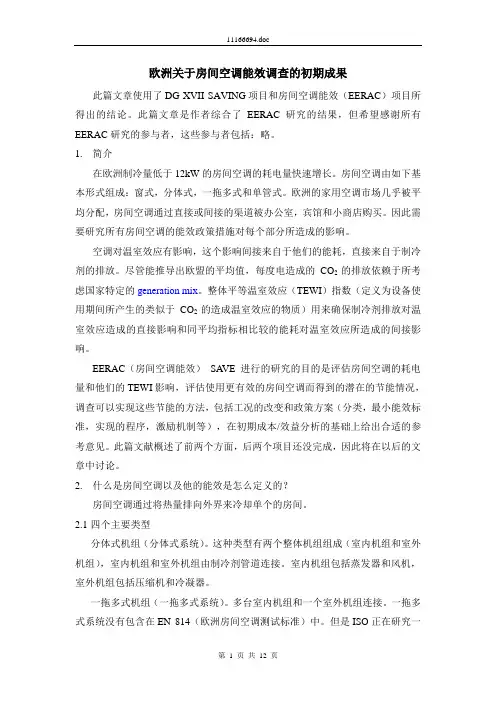
欧洲关于房间空调能效调查的初期成果此篇文章使用了DG XVII SAVING项目和房间空调能效(EERAC)项目所得出的结论。
此篇文章是作者综合了EERAC研究的结果,但希望感谢所有EERAC研究的参与者,这些参与者包括:略。
1.简介在欧洲制冷量低于12kW的房间空调的耗电量快速增长。
房间空调由如下基本形式组成:窗式,分体式,一拖多式和单管式。
欧洲的家用空调市场几乎被平均分配,房间空调通过直接或间接的渠道被办公室,宾馆和小商店购买。
因此需要研究所有房间空调的能效政策措施对每个部分所造成的影响。
空调对温室效应有影响,这个影响间接来自于他们的能耗,直接来自于制冷剂的排放。
尽管能推导出欧盟的平均值,每度电造成的CO2的排放依赖于所考虑国家特定的generation mix。
整体平等温室效应(TEWI)指数(定义为设备使用期间所产生的类似于CO2的造成温室效应的物质)用来确保制冷剂排放对温室效应造成的直接影响和同平均指标相比较的能耗对温室效应所造成的间接影响。
EERAC(房间空调能效)SA VE进行的研究的目的是评估房间空调的耗电量和他们的TEWI影响,评估使用更有效的房间空调而得到的潜在的节能情况,调查可以实现这些节能的方法,包括工况的改变和政策方案(分类,最小能效标准,实现的程序,激励机制等),在初期成本/效益分析的基础上给出合适的参考意见。
此篇文献概述了前两个方面,后两个项目还没完成,因此将在以后的文章中讨论。
2.什么是房间空调以及他的能效是怎么定义的?房间空调通过将热量排向外界来冷却单个的房间。
四个主要类型分体式机组(分体式系统)。
这种类型有两个整体机组组成(室内机组和室外机组),室内机组和室外机组由制冷剂管道连接。
室内机组包括蒸发器和风机,室外机组包括压缩机和冷凝器。
一拖多式机组(一拖多式系统)。
多台室内机组和一个室外机组连接。
一拖多式系统没有包含在EN 814(欧洲房间空调测试标准)中。
但是ISO正在研究一拖多式测试标准,而且测试实验室已经假定了室内机组的连接情况,并使用了标准。
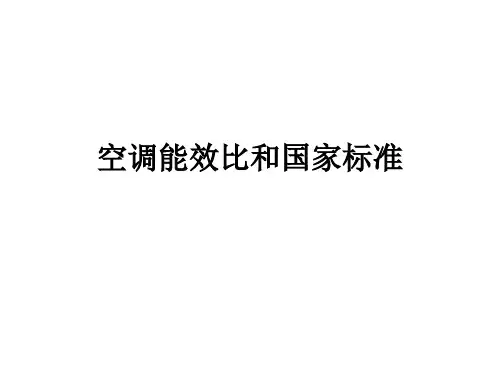
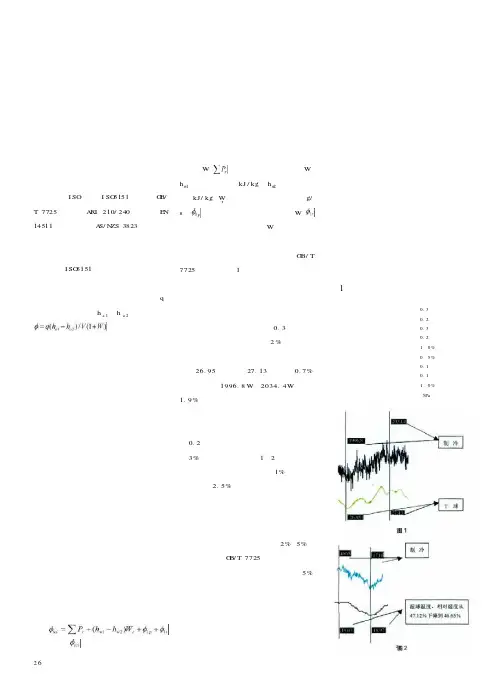
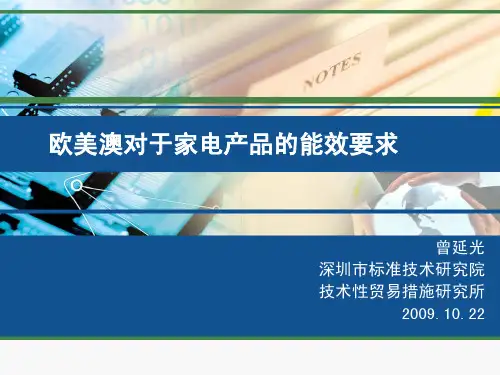
欧洲新能耗指令培训汇总一、使用标准1、206/2012能效指令、626/2011生态指令、EN14511/2011空间加热/冷却的电驱动压缩机的空调器。
2、测试方法依据:EER/COP——EN14511-2011 SEER/SCOP——EN14825-2010噪声——EN12102-2008 待机功耗——EN62301-2006二、适用范围和内容1、制冷量、制热量≤12KW;2、R22、R410A、R407C的GWP≥1503、单、双风管机不考虑SEER、SCOP,还是按原EER、COP进行测试,但有待机功耗要求(待机≤1W,显示信息≤2W);4、对所有空调器(单、双风管机)都规定了噪声限值要求,并且噪声的测试不是采用声压级,而是声功率级;5、欧洲新指令中制热划分三个区域:平均气温区、寒冷气温区、温暧区,其中对SCOP要求是以平均气温区为标准测试;6、电源管理,如果失去了基本功能,则不适用;7、SEER、SCOP≥92% EER、COP≥90% 噪声≤标称+2 dB(A),且满足最低限值要求能力≥92%三、对现有设备的要求1、焓差报告模板更改和软件升级。
a) 测试稳定情况下,额定制冷不变,采样间5min,共35min(采7组);额定制热:采样5min,共70min(采14组); b) 对于制热出现非稳态测试过程中数据记录与积分计算有要求; c) 积分计算SEER/SCOP计算。
2、焓差室工况的控制能力需加强,电参数精度符合要求。
现有设备铂电阻精度满足要求,但工况控制的稳定性≤±0.3℃,电参数误差要求:功率计≤±1%,频率≤±0.6;3、焓差室工况范围控增大,室外最低稳定工况-22℃1小时以上(寒冷区),对平均温区也要达到-10℃(通过表5确定);4、增加待机功耗测试设备,要求精度功率≤0.01W;5、噪声测试要求能进行声功率测试。
四、SEER、SCOP测试的有关细节1、不同模式待机功耗P TO、P CK、P OFF、P SB:用仪表进行测试得到,当没有关机模式P OFF时用P SB值代替(表示有两个待机模式)--------中山长虹现分体机是没有关机模式,机械式窗机有,即:关机模式的判定为无信号接收,否则为待机模式;2、不同模式待机功耗对应小时数H TO、H CK、H OFF、H SB;3、设计负荷Pdesignc(制冷)、Tdesignh(制热):是由工厂设计师确定的,标高或标低要有一定要求的,一般应满足不小于铭牌额定制冷/热量92%(很多工况直接按:Pdesignc=铬牌额制冷量,Tdesignh=铬牌额制热量+电加热(如果有电加热,没有为0));4、每个对应点的部分负荷用Pc(T j) 、Ph (T j)表示。
关于欧盟空调新能效标准ErP要求、试验和计算方法介绍田磊
【期刊名称】《电器》
【年(卷),期】2013(0)S1
【摘要】本文简要介绍了新版空调能效标准EN 14825-2012的要求、试验工况和计算方法,重点解释了关键术语的涵义,并表明其在计算ErP中的重要性。
【总页数】7页(P193-199)
【关键词】能源相关产品;设计负荷;制冷负荷;制热负荷;待机功耗;关机功耗
【作者】田磊
【作者单位】珠海格力电器股份有限公司
【正文语种】中文
【中图分类】TM925.12
【相关文献】
1.关于欧盟市场空调新能效的测试要求 [J], 臧松彦;刘勃宏
2.欧盟空调及热泵新能源标签指令及ErP指令介绍 [J], 钟文初
3.基于EN14825标准规定下的房间空调器季节能效计算方法解析及变频空调器性能设计方法探讨 [J], 汪东明;鲁益军
4.欧盟ErP能效计算方法解析与试验研究 [J], 王月;苏东波
5.欧盟空调ERP能效新法规草案解读及季节能效优化探讨 [J], 卢智斌;陈信勇因版权原因,仅展示原文概要,查看原文内容请购买。
空调产品能效检验流程与标准要求空调产品能效检验流程与标准要求随着全球气候变暖和人们对生活质量要求的提高,空调产品已经成为现代家庭和办公室不可或缺的电器。
然而,由于空调产品运行时的高耗能特性,对其能源效率的要求也越来越高。
为了确保空调产品的能效性能符合规定的标准,制定了一套空调产品能效检验流程和标准要求。
首先,空调产品能效检验应包括两个方面的内容,即制冷效能和能耗水平。
其次,制冷效能检验主要包括制冷工况和加热工况下的制冷量、加工量和能效比等指标的测量。
制冷工况下的制冷量和加工量是指在设计工况下,空调产品吸热器输出的制冷量和加热量。
能效比是指空调产品在运行过程中的能量输入与制冷量或加工量之间的比值,用于评估空调产品的能源利用效率。
能耗水平检验主要是通过测量空调产品在运行状态下的功耗和运行时间来评估其能耗水平。
在进行空调产品能效检验时,需要按照相关标准要求采用合适的测试设备和仪器进行测试。
测试设备和仪器应具备较高的精确度和准确性,以确保测试结果的可靠性和可重复性。
测试过程应遵循标准操作程序,确保所有的测试参数和条件都符合标准要求。
例如,测试设备和仪器应在标定状态下进行,测试环境的温度、湿度和大气压力等条件应符合要求。
空调产品能效的标准要求主要包括能源效率等级和能效比要求。
能源效率等级是根据能效比的大小将空调产品分为不同的等级,从而反映了空调产品的能源利用效率。
能源效率等级通常从低到高分为五个等级,分别为一级、二级、三级、四级和五级,等级越高代表能源利用效率越高。
能效比要求是指空调产品在运行过程中,其能效比应满足最低要求。
能效比的最低要求通常根据空调产品的类型和规格来确定。
总结来说,空调产品能效检验流程主要包括制冷效能和能耗水平的检验。
制冷效能检验包括制冷量、加工量和能效比等指标的测量,能耗水平检验则主要是测量功耗和运行时间。
在进行能效检验时,需要采用合适的测试设备和仪器,按照标准要求进行测试,并且要求测试结果具备可靠性和可重复性。
欧洲空调规范标准最新随着全球对环境保护和能源效率的日益重视,欧洲在空调设备规范标准上也进行了一系列的更新和改进。
以下是欧洲空调规范标准的最新要点:1. 能效标准欧洲的空调能效标准主要遵循欧盟的Ecodesign指令和ErP(能源相关产品)指令。
这些指令规定了空调设备必须达到的最低能效要求,以减少能源消耗和温室气体排放。
最新的能效标签制度,如EU Energy Label,为消费者提供了清晰的能效信息,帮助他们做出更环保的选择。
2. 制冷剂规定欧洲对空调制冷剂的使用有着严格的规定,以减少对臭氧层的破坏和全球变暖的潜在影响。
根据F-Gas法规,某些对环境有害的制冷剂已被禁止或限制使用,同时鼓励采用更环保的替代品。
3. 安全标准空调设备的安全性是欧洲规范中的另一个重要方面。
这包括对电气安全、机械安全以及防火性能的要求。
所有在欧洲市场上销售的空调设备都必须符合相应的CE标志指令,以证明其符合欧盟的安全、卫生和环保要求。
4. 性能和测试标准为了确保空调设备的性能符合消费者的期望,欧洲制定了一系列的性能和测试标准。
这些标准涵盖了空调的冷却能力、噪音水平、空气流通量等方面,确保产品在实际使用中能够达到宣称的性能。
5. 环境影响评估欧洲空调规范还包括对产品整个生命周期环境影响的评估。
这不仅包括使用阶段的能耗,还包括生产、运输、维护和最终废弃阶段的环境影响。
6. 智能技术集成随着智能家居技术的发展,欧洲的空调规范也鼓励集成智能控制系统,以提高能效和用户舒适度。
这些系统可以远程控制,自动调节温度,并与其他智能家居设备协同工作。
7. 建筑集成在建筑设计中,欧洲规范也鼓励将空调系统与建筑本身更紧密地集成,以优化能源使用和提升室内环境质量。
结论欧洲空调规范标准的更新反映了对环境保护、能源效率和用户安全的持续承诺。
随着技术的不断进步和全球对可持续发展目标的追求,这些规范标准将继续发展和完善,以满足未来的挑战。
请注意,以上内容是基于对欧洲空调规范标准的最新发展的一般性描述,具体标准和法规可能会有所变化,建议查阅最新的官方文件和资源以获取详细信息。
家电产品ERP能效认证标准与流程ERP介绍:在环保、节能的倡导下,全世界都在关注环保、节能的产品。
ERP是欧洲的能耗认证,目前,通过法规要ERP认证、WSTC认证检测的产品有:机顶盒ERP认证、数码相框ERP认证、LCD显示器ERP 认证、电源适配器ERP认证、电脑ERP认证、电视机ErP认证、充电器ErP认证、节能灯ErP认证、灯具的ERP认证。
欧盟规定:所有在欧洲销售的电子电器产品必须要达到ERP检测或ERP认证要求(欧洲能耗有关联的产品节能要求)相关的节能认证指令:2000/55/EC——关于荧光灯镇流器能效检测要求。
(检测标准:EN50294:1998)98/11/EC——关于家用灯具能源标签检测要求。
(检测标准:EN50285:1999)2003/66/EC——电冰箱、冰柜及制冷设备能效要求。
(检测标准:EN153:2006)2002/31/EC——空调能效标识指令。
(检测标准:EN14511系列) 2002/40/EC——电烤炉能效标识指令。
(检测标准:EN50304:2001)95/13/EC——家用干衣机能源标识指令。
(检测标准:EN50229:2007)97/17/EC——洗碗机能源标识指令。
(检测标准:EN50242:1998)92/75/EEC——家用电器能源标识的框架指令。
ERP认流流程:1:确定认证产品→客户递交认证申请→产品检测→(合格)出检测报告→网上申请备案2:确定认证产品→客户递交认证申请→产品检测→(不合格)客户整改→重新检测→(合格)出检测报告→网上申请备案ERP认证周期:因产品不同,所采用的检测标准不同,所要求的检测周期也不同;一般在7个工作日。